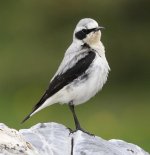Richard Klim
-------------------------
Delingat, Hobson, Dierschke, Schmaljohann & Bairlein 2010. Morphometrics and stable isotopes differentiate populations of Northern Wheatears (Oenanthe oenanthe). J Ornithol: in press.
www.springerlink.com/content/7010228p61341173
[Presumably separation of leucorhoa from nominate.]
Richard
www.springerlink.com/content/7010228p61341173
[Presumably separation of leucorhoa from nominate.]
Richard






